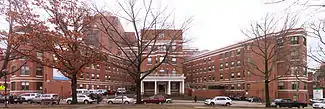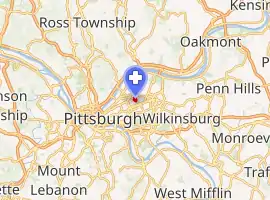Western Pennsylvania Hospital
The Western Pennsylvania Hospital, commonly referred to as "West Penn Hospital", is located at 4800 Friendship Avenue in the Bloomfield neighborhood of Pittsburgh, Pennsylvania. The 317-bed hospital is part of the Allegheny Health Network.[2] It serves as a Clinical Campus of Temple University School of Medicine,[3] offering medical education, including a large number of residency and fellowship programs, as well as its own nursing program on campus.
| West Penn Hospital | |
|---|---|
| Allegheny Health Network | |
 | |

| |
| Geography | |
| Location | 4800 Friendship Avenue, Pittsburgh, Pennsylvania, United States |
| Coordinates | 40°27′41″N 79°56′47″W |
| Organization | |
| Funding | Non-profit hospital |
| Affiliated university | Temple University |
| Services | |
| Beds | 317 |
| History | |
| Opened | 1848 |
| Links | |
| Website | www.ahn.org |
| Lists | Hospitals in Pennsylvania |
| Designated | 1973[1] |
Founded on March 18, 1848,[4] as Pittsburgh's first chartered public hospital, West Penn was built Pittsburgh's 12th ward, on a hillside overlooking the city's Strip District and adjacent to what is now Polish Hill (today, that plot is home to a ballfield and West Penn Park, after having been sold to the City of Pittsburgh). The four-story, 120-patient hospital finally opened in spring 1853,[4] after five years of design, construction and funding setbacks. During its early years, many of the patients were those injured by industrial accidents in Pittsburgh's mills and rail yards.[5] Others had mental illness, and in 1862, West Penn opened the Dixmont Hospital[4] (known officially as the "Department of the Insane in the Western Pennsylvania Hospital of Pittsburgh”) on a steep bluff overlooking the Ohio River, about eight miles downriver from West Penn.
That hospital, the first specialized mental health facility in Western Pennsylvania, remained under West Penn's ownership until 1907.
Eight years after the opening of West Penn Hospital, the American Civil War began, and West Penn became a primary triage center serving Union Forces. Because of its size, and because it was a public hospital not bound by religious affiliations, the United States government commandeered West Penn Hospital in 1862, making alterations to it and turning it into a military hospital for the next three years.[6] (Civilians could still be treated at West Penn in emergency situations). By the end of the Civil War in 1865, some 3,000 soldiers had been treated at West Penn.
The West Penn Medical College, founded by West Penn surgeons and doctors, opened in October 1885, with a class of 55 students. It was the region's first medical school.
By the turn of the 20th Century, the original hospital was outdated, and the hospital's board agreed to build a new hospital in Pittsburgh's Bloomfield neighborhood, about a mile to the east. The cornerstone was laid in 1909, and on New Year's Day, 1912, the new West Penn Hospital opened, and 219 patients then in the hospital's care were moved to the new hospital.[4] The six-story, X-shaped hospital was able to accommodate up to 500 patients, and featured modern operating rooms, laboratories, and X-ray machines.
In 1919, the hospital purchased another property on Friendship Avenue and by 1923 had opened a "Residence and Training School", now the West Penn School of Nursing.[5] The building currently houses nurse educators and students as well as the Simulation Teaching, Academic Research (STAR) Center.
In 1950, West Penn added a new obstetrical wing, an intensive care unit came in 1958, and by the 1960s, another substantial expansion was underway; West Penn launched a capital campaign to build a new entrance to the hospital along Millvale Avenue, and to build a new ambulatory care center along Liberty Avenue (to be named Mellon Pavilion).[4] Both Mellon Pavilion and the hospital's renowned Burn Care Unit opened in 1970, a heliport was added in 1971, and the East Tower, which specialized in diagnostic and critical care, opened in 1981. A nine-story patient care tower was added in 1995, topped by a copper dome visible for miles.[4]
The late 1990s and early 2000s resulted in several changes to West Penn's governance structure. Following the fall of AHERF[7] and its historic 1998 bond default, West Penn Hospital agreed to rescue AGH and its affiliates through a merger. As alternative to bankruptcy liquidation, AGH, Forbes, Allegheny Valley and Canonsburg “were transferred to the West Penn system in 1999 in exchange for a $25 million payment to the creditors, who agreed to release [AGH] from liability for all claims.”[7] That new system was known as the West Penn Allegheny Health System.
In 2010, as parent company West Penn Allegheny Health System was experiencing severe cash shortages and financial difficulties, WPAHS leadership agreed to close West Penn's emergency room as a cost-saving measure.[8] It closed on Jan. 1, 2011, and remained closed until February 2012,[9] after WPAHS had reached an agreement in principle with Highmark Inc. regarding the acquisition of the hospital system. That agreement was announced in June 2011, and without the affiliation and capital infusion from Highmark, had “another investor not materialized, WPAHS was preparing a budget that would have included the autumn closure of West Penn Hospital,” according to the Pittsburgh Post-Gazette. West Penn became a part of Allegheny Health Network in 2013.[2]
Today, West Penn Hospital is a 317-bed academic medical center; its obstetrical program delivers 4,000 babies a year,[10] and the hospital's Level III neonatal intensive care unit, its adult and pediatric certified burn trauma center, its extended-hours oncology clinic and dozens of other services draw patients from across the state. West Penn was the first hospital in southwestern Pennsylvania to receive the prestigious Magnet Recognition Program award for nursing excellence American Nurses Credentialing Center, in 2006, and it is also the first in the region to be re-designated for a third consecutive time.[11]
Gallery
 West Penn West Wing Entrance
West Penn West Wing Entrance Friendship parklet next to West Penn
Friendship parklet next to West Penn.jpg.webp) Aerial postcard view
Aerial postcard view Old postcard view of the "new" West Penn Bloomfield site
Old postcard view of the "new" West Penn Bloomfield site
References
- Historic Landmark Plaques 1968-2009 (PDF). Pittsburgh, PA: Pittsburgh History & Landmarks Foundation. 2010. Retrieved 2010-07-02.
- "Highmark, West Penn cement deal". Pittsburgh Post-Gazette. Retrieved 2018-06-29.
- "Temple and West Penn Allegheny Health System to establish Pittsburgh medical school campus | Temple Now". news.temple.edu. Retrieved 2018-06-29.
- McCullough, Hax (1998). The People of Progress: The Sesquicentennial History of the Western Pennsylvania Hospital: 1848-1998. The Western Pennsylvania Hospital.
- Horvath, William J.; Cristina, Raymond J. (1973). West Penn Heritage: 125 Years, 1848-1973. Printed by Albert E. Deeds Associates. Pittsburgh, PA: The Western Pennsylvania Hospital. pp. 8–12, 30, 34–35.
- "Nursing roots deep in Civil War". The Blade. 2013-06-30. Retrieved 2018-06-29.
- Burns, L R; Cacciamani, J; Clement, J; Aquino, W. "The fall of the house of AHERF: the Allegheny bankruptcy". Health Affairs. 19 (1): 7–41. doi:10.1377/hlthaff.19.1.7. ISSN 0278-2715.
- "West Penn Hospital cutting 1,500; emergency room closing". New Pittsburgh Courier. 2010-07-07. Retrieved 2018-06-29.
- "West Penn Hospital Announces Emergency Room Reopening". WTAE. 2012-02-13. Retrieved 2018-06-29.
- "Highmark Health: 990 tax return" (PDF). Foundation Center.
- "AHN's West Penn Hospital Earns Record Third Magnet Recognition® Designation, Nation's Leading Indicator of Nursing Excellence | ahn.org". ahn.org. 2017-11-15. Retrieved 2018-06-29.
